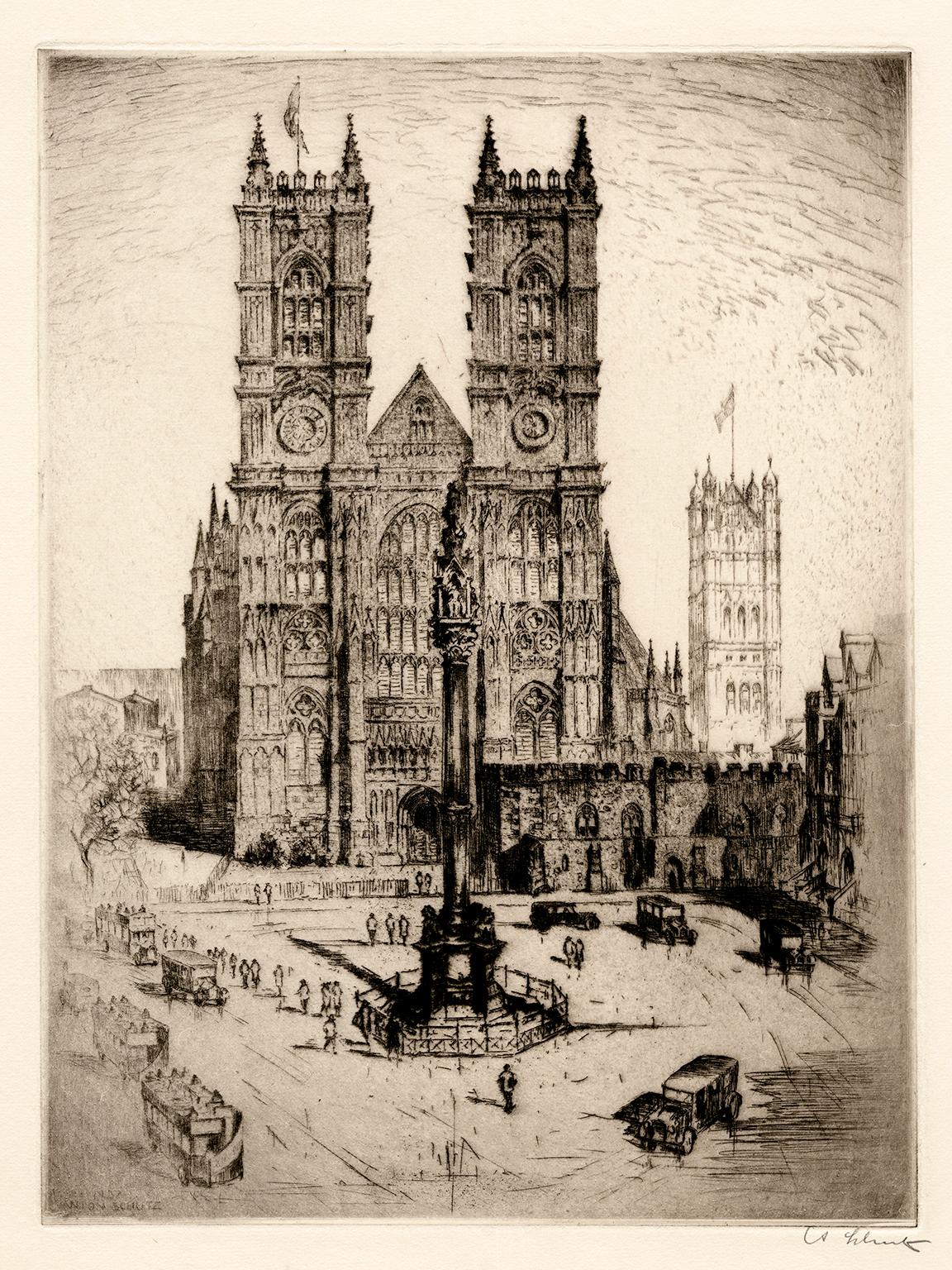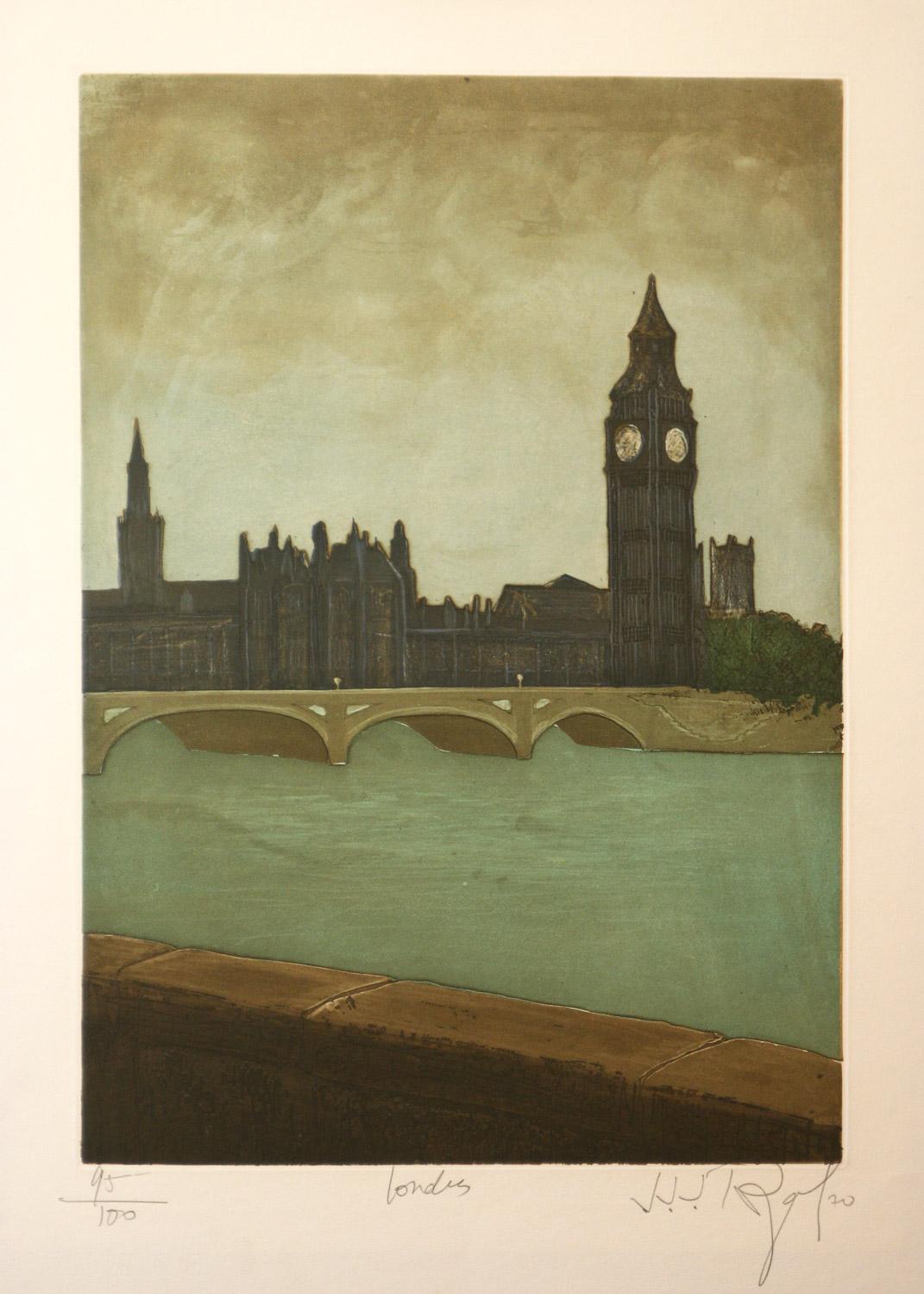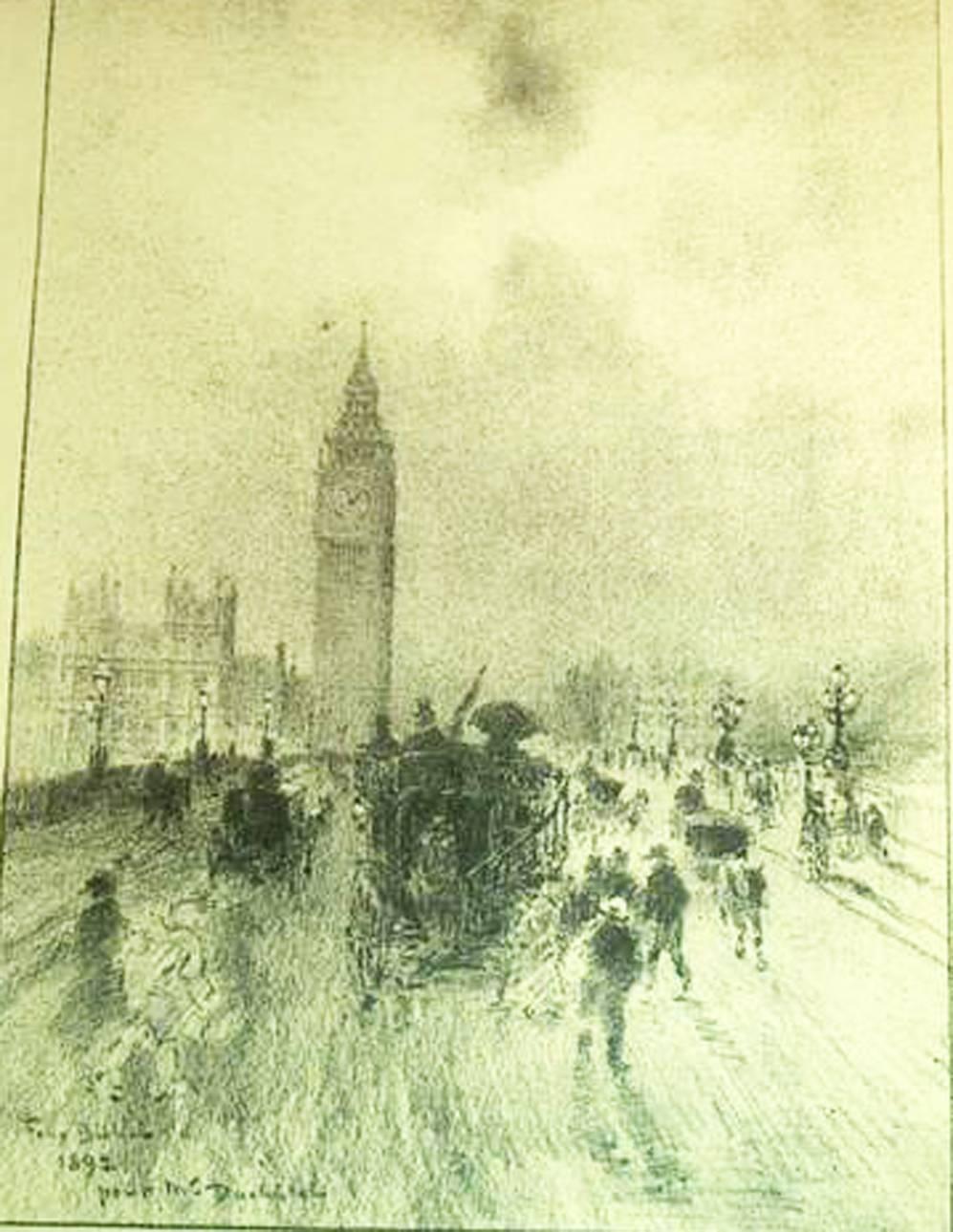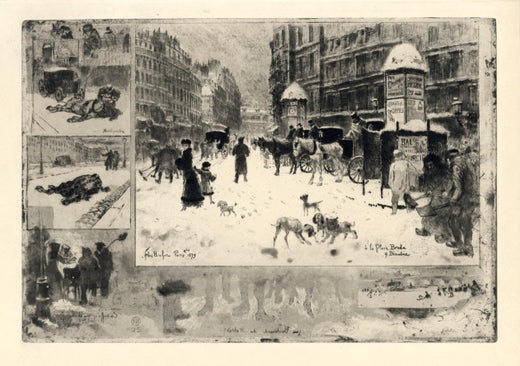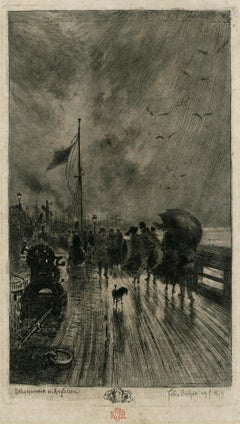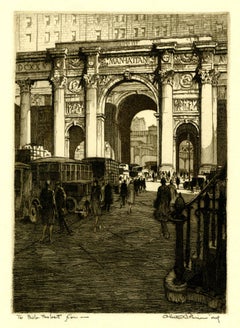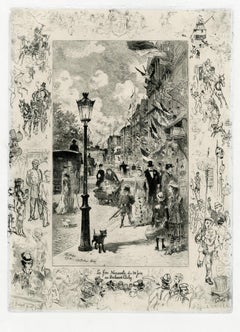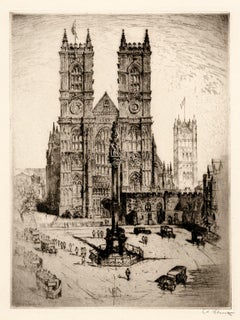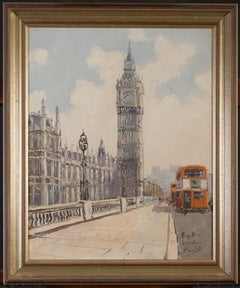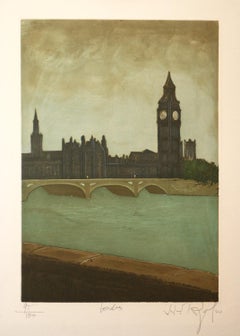Artículos similares a Westminster Palace
¿Quieres más imágenes o vídeos?
Solicita imágenes o vídeos adicionales al vendedor
1 de 12
Félix Hilaire BuhotWestminster Palace1884
1884
3039,20 €
Envío
Recuperando presupuesto…La promesa de 1stDibs
Garantía de autenticidad,
Garantía de devolución de dinero,
Cancelación dentro de las 24 horas
Acerca del artículo
Westminster Palace
Etching, Drypoint, Aquatint, roulette and salt ground lift
1884
Depicts the Houses of Parliament, Big Ben Clock and Tower and the River Thames in the foreground.
Signed with the artist’s large Red Owl stamp, Lugt 977
Printed on thin wove japan, (almost parchment like) with full margins
A rich cleaned whipped impression showing burr in the central compositions, the remarques printing with atmospheric selective inking
This example is one of three depictions of Westminster that the artist created. One similar format etching and a vertical lithograph.
Condition: Excellent
Image/Plate Size: 11 7/16 x 15 5/8 inches
Sheet size: 14 1/4 x 18 3/4 inches
Reference: Bourcard/Goodfriend 155 vi/VIII, before the words "In pro..."
A rare proof
Impressions of this image are the collections of the following institutions:
Art Institute of Chicago
Minneapolis Institute of Art
Metropolitan Museum of Art
Van Gogh Museum
National Gallery of Art, Washington
High Museum, Atlanta
British Museum
Smart Museum, Chicago (canceled plate impression)
Achenbach Foundation of the Graphic Arts, FAMSF
Considered one of the artist's finest images.
Félix-Hilaire Buhot
French, 1847 - 1898
Among the most original prints made in France during the last quarter of the nineteenth century are those by Félix Buhot. Born in 1847 in the small Normandy town of Valognes, in northern France, Buhot moved to Paris in 1865, where a year later he enrolled in the École des Beaux-Arts, studying painting and drawing under various artists. Buhot first learned to etch in about 1873, producing his first etching later that year and quickly establishing himself as a successful printmaker. The young artist made his living by decorating fans and illustrating lithographic sheet music. Buhot lived and worked most of his life in Paris, with frequent visits back to northern France and extended trips to England where he met his wife, Henrietta Johnston, whom he married in 1881. By 1892 Buhot had ceased making prints, and in 1898, after suffering prolonged bouts of deep depression, he died at the age of fifty-one.
Along with Edgar Degas and Camille Pissarro, Félix Buhot numbers among the most experimental printmakers of his day. In exploring the unique aspects of etching, he developed an approach to printmaking that was very painterly; in fact he called his prints "paintings on copper." A true printmaker's printmaker, Buhot delighted in all the technical variables and regularly combined multiple processes to produce a single print: he achieved even greater tonal variation by employing the more traditional techniques of etching, drypoint, and aquatint along with several less familiar methods. Unlike many contemporary printmakers who disliked photography, Buhot heartily embraced the medium and used it as a creative aid. He also used different inks and papers for varied effects. His most original contribution to the history of printmaking is a device he termed marges symphoniques (symphonic margins): by amplifying the main subject, such illustrations became an integral part of the print.
In his many prints of city views and seascapes, Buhot was intent on creating a specific atmosphere, especially the effects of weather such as rain, snow, mist, and fog. He turned to his immediate neighborhood in and around the boulevard de Clichy in Montmartre, Paris, for inspiration for his prints of everyday city life. Buhot delighted in portraying the varied street life of the vibrant capital city not only in different seasons (Winter in Paris, 1879) but also in moments of public display, from a festive holiday celebration (National Holiday on the Boulevard de Clichy, 1878) to a somber death observance (Funeral Procession on the Boulevard de Clichy, 1887). His city views also include London scenes (Westminster Palace and Westminster Bridge, both of 1884). And Buhot's love for the sea is evidenced in the many prints exploring its ever-changing atmospheric conditions and moods. Buhot's boat trips to England inspired two of his most characteristic prints, A Pier in England and Landing in England, both from 1879.
With his experimental printmaking techniques, Buhot became one of the best-known, admired, and collected printmakers of his day. He achieved success for his prints at the annual Salons between 1875 and 1886, and a number of his works were published in leading periodicals and books. He also found critical acclaim and support for his prints in the United States, especially after his first one-man exhibition organized by the New York print dealer Frederick Keppel in 1888.
Courtesy: National Gallery of Art, Washington, D. C.
- Creador:Félix Hilaire Buhot (1847 - 1898, Francés)
- Año de creación:1884
- Dimensiones:Altura: 29,11 cm (11,46 in)Anchura: 39,71 cm (15,63 in)
- Medio:
- Movimiento y estilo:
- Época:
- Estado:
- Ubicación de la galería:Fairlawn, OH
- Número de referencia:Vendedor: FA111551stDibs: LU14014196842
Félix Hilaire Buhot
Los grabados de Buhot se realizaron en una época de renovado interés por el grabado original (especialmente el aguafuerte), que se estaba popularizando rápidamente más que el grabado reproductivo. Ya en 1874, el preeminente crítico Philippe Burty elogió sus grabados, admirando las belles épreuves (bellas pruebas) del artista, término que Burty utilizó para designar las impresiones raras, magníficamente entintadas, impresas por el propio artista. En la década de 1880, Buhot se había convertido en uno de los grabadores más conocidos y coleccionados de su época. El renombre de Buhot se extendió mucho más allá de su propio país, y también disfrutó de la aclamación de la crítica y de un fuerte apoyo a sus grabados en Estados Unidos. En 1888, el comerciante de grabados neoyorquino Frederick Keppel (1845-1912) ofreció a Buhot su primera exposición individual, que tuvo bastante éxito. Además de con Keppel, Buhot entabló amistad con dos destacados coleccionistas estadounidenses de finales del siglo XIX, que acumularon un gran número de grabados del artista: Samuel P. Avery (1822-1904), de Nueva York, coleccionó más de 300 grabados, y George A. Lucas (1824-1909), de Baltimore, poseyó unos 200 grabados. A partir de 1911, otra gran colección fue formada por Albert H. Wiggin (1868-1951), de Boston, que compró más de 150 impresiones. En la actualidad, estas colecciones se encuentran, respectivamente, en la Biblioteca Pública de Nueva York, el Museo de Arte de Baltimore y la Biblioteca Pública de Boston.
Sobre el vendedor
5,0
Vendedor reconocido
Estos prestigiosos vendedores son líderes del sector y representan el escalón más alto en cuanto a calidad y diseño de artículos.
Vendedor Oro
Vendedores premium que mantienen una calificación de +4,3 y tiempos de respuesta de 24 horas
Establecido en 1978
Vendedor de 1stDibs desde 2013
799 ventas en 1stDibs
Tiempo de respuesta usual: <1 hora
Asociaciones
International Fine Print Dealers Association
- EnvíoRecuperando presupuesto…Envío desde: Akron, OH
- Política de devolución
Partes de esta página se han traducido automáticamente. 1stDibs no puede garantizar la exactitud de las traducciones. El inglés es el idioma predeterminado de este sitio web.
Garantía de autenticidad
En el improbable caso de que haya algún problema con la autenticidad de un artículo, ponte en contacto con nosotros en un plazo de 1 año para recibir un reembolso total. DetallesGarantía de devolución de dinero
Si tu artículo no es como se describe, sufre daños durante el transporte o no llega, ponte en contacto con nosotros en un plazo de 7 días para recibir un reembolso total. DetallesCancelación dentro de las 24 horas
Tienes un período de gracia de 24 horas para reconsiderar tu compra, sin preguntas.Vendedores profesionales aprobados
Nuestros vendedores de primera clase deben cumplir estrictos estándares de servicio para mantener la integridad de nuestros anuncios.Garantía de igualación de precios
Si encuentras que un vendedor publicó el mismo artículo por un precio menor en otro lado, igualaremos ese precio.Entrega global de confianza
Nuestra red de transporte de primera ofrece opciones de envío especializado en todo el mundo, que incluye envío personalizado.Más de este vendedor
Ver todoUn Debarquement en Angleterre (Un Desembarco en Inglaterra)
Por Félix Hilaire Buhot
Un Debarquement en Angleterre
(Un desembarco en Inglaterra)
aguafuerte, punta seca, aguatinta, ruleta y aguarrás, 1879
Firmado con el sello del búho rojo del artista, Lugt 977 (ver ...
Categoría
Década de 1870, Impresionista, Impresiones de paisajes
Materiales
Punta seca
El edificio municipal de Manhattan
Por Chester B. Price
Firmado a lápiz y anotado "imp" abajo a la derecha; Dedicado abajo a la izquierda: "A Bob Nisbet de...".
Nota: Diseñado por William M. Kendall de McKim, Mead y White, este rascaci...
Categoría
Década de 1910, Impresiones de paisajes
Materiales
Punta seca
Calle Fleet, Londres
Por Luigi Kasimir
Calle Fleet, Londres
Aguafuerte y aguatinta, c. 1936
Firmado a lápiz por el artista (ver foto)
Estado de conservación: Muy buen estado, con cinta de papel marrón en los bordes de los...
Categoría
Década de 1930, Impresiones de paisajes
Materiales
Grabado químico, Grabado en madera
La Fiesta Nacional del Boulevard Clichy
Por Félix Hilaire Buhot
La Fiesta Nacional del Boulevard Clichy
Aguafuerte, punta seca y aguatinta, 1878
Firmado abajo a la izquierda en la placa (ver foto)
Impreso chine collee, montado sobre papel de esta...
Categoría
Década de 1870, Escuela francesa, Impresiones figurativas
Materiales
Grabado químico
Palacio, Florencia
Por Rudy O. Pozzatti
Palacio, Florencia
Aguafuerte, grabado, aguatinta, tierra blanda y tierra levantada, impresos en colores a partir de tres planchas de cobre. 1954
Firmado a lápiz abajo a la derecha (...
Categoría
Década de 1950, moderno estadounidense, Impresiones de paisajes
Materiales
Acuatinta
El Duomo, Florencia
Por Donald Shaw MacLaughlan
El Duomo, Florencia
Acuarela, 1914
Firmado y fechado en el borde inferior central (ver foto)
La Catedral de Florencia, formalmente Cattedrale di Santa Maria del Fiore, es la catedra...
Categoría
Década de 1910, moderno estadounidense, Dibujos y acuarelas de paisajes
Materiales
Acuarela
También te puede gustar
Palacio de Westminster
Por Félix Hilaire Buhot
Félix Buhot (1847-1898), Palacio de Westminster, aguafuerte, punta seca, ruleta, 1884, firmado a lápiz y ampliamente anotado. Bourcard/Goodfriend 155, tercer estado de Bourcard (de 5...
Categoría
Década de 1880, Impresionista, Impresiones de paisajes
Materiales
Punta seca, Grabado químico
Abadía de Westminster" - Iglesia Real, Londres
Por Anton Schutz
Anton Schutz, "Abadía de Westminster", aguafuerte, edición sin determinar, 1927. Firmado a lápiz. Firmado y fechado en la plancha, abajo a la izquierda. Una impresión magnífica, rica...
Categoría
Década de 1920, realista estadounidense, Impresiones de paisajes
Materiales
Grabado químico
Big Ben, Westminster, Londres. 1970's
Morris o Morius, un pintor desconocido que tiene un don para la pincelada extravagante y arrogante, claramente un artista muy experimentado y seguro de sí mismo, que permanece en el...
Categoría
Década de 1970, Pinturas de paisajes
Materiales
Óleo, Tablero
Londres, Inglaterra aguafuerte original firmado por J.J. Regal
Londres, Inglaterra es un aguatinta original firmado de edición limitada aguafuerte del artista francés J.J. Regal impreso en papel BFK Rives. Se trata de un diseño muy atrevido...
Categoría
siglo XX, Expresionista, Impresiones de paisajes
Materiales
Grabado químico
Acuarela de mediados del siglo XX - Casas del Parlamento desde Whitehall Court
Una encantadora vista de las Casas del Parlamento desde Whitehall Court al anochecer. Inscrita con la ubicación en la parte inferior derecha. Inscripción ilegible con firma. Presenta...
Categoría
siglo XX, Dibujos y acuarelas de paisajes
Materiales
Acuarela
211 € Precio de venta
Descuento del 20 %
LA TORRE DEL RELOJ VICTORIA, LONDRES
Por Félix Hilaire Buhot
Buhot, Félix. LA TORRE DEL RELOJ VICTORIA, LONDRES BG 184. Litografía, 1892. 9 x 6 3/8 pulgadas; 230 x 163 mm, imagen; hoja 15 x 11 pulgadas; 381 x 279 mm. Firmado en la piedra "Feli...
Categoría
Década de 1890, Impresiones de paisajes
Materiales
Litografía
